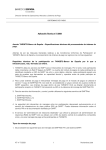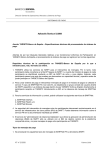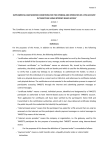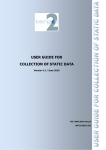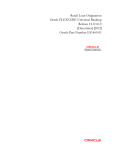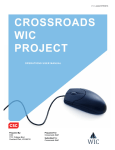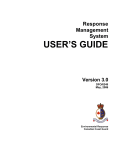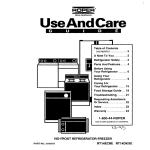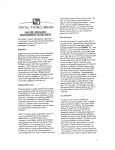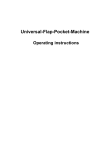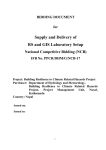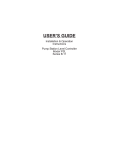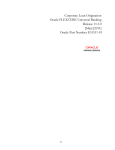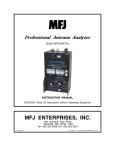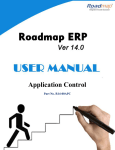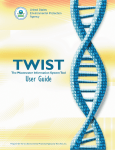Download TARGET2 user Manual v1.3 changes
Transcript
TARGET2 User Manual for the event of a participant/CB failure and Contingency Version 1.3 / 26th November 2012 © 2006 Copyright Banca d'Italia - Banque de France - Deutsche Bundesbank (3CB): Reproduction for non-commercial purposes is authorised, with acknowledgement of the source. Changes would require the prior consent of 3CB. Content Versioning No. Date Comments 0.1 02-16-2007 First draft Final 0.2 09-06-2007 First draft of all chapters Final 1.0 11-29-2007 Final version Final 1.1 09-07-2010 Backup functions updated (EURO1, via External CB, Sub frame MT202) Final 1.2 20-07-2012 Inclusion of Start of procedure/cycle Final 1.3 26-11-2012 Inclusion of the Insert/ change Logo function Final for the event of a participant/CB failure and Contingency Status Page 2 of 45 1 Introduction 1.1 Objectives, scope and structure 2.1.1 Front page 1 Introduction To provide for the smooth running of the business day, also during a contingency, the possibility to act on behalf of a failed participant has been implemented in TARGET2. In the situation that the participant (CI, AS, financial institution) has failed due to a technical problem on the participant site, the responsible CB may carry out certain tasks on behalf of the failed participant via the ICM. In addition, if the responsible CB is not able to support their participants and also not able to carry out the tasks normally assigned to it, the SSP Operational Team can act on behalf of the failed CB. In this unusual situation the forms set out in this document must be used. Contingencies are also covered by the forms. In the event that the SSP fails, the Contingency Module (CM) will be used. Only the SSP Operational Team (OT) is allowed to open the Contingency Module, according ot the procedures set out in the T2 Manual of Procedures. The SSP OT together with the responsible CB acting on behalf of its participant will be able to access the CM. All business cases in the CM are covered by two different forms (Payments and Form II). These forms are: • Mandatory in the relationship between the responsible CB and SSP Service Desk (both for CB`s own business and the business acting on behalf of their participant, in case the responsible CB is not able to support their participants) • Optional in the relationship between the participants and the responsible CB; if not used on the national level, the responsible CB has to fill in these forms, in case the responsible CB is not able to support their participants and the SSP OT has to act on behalf of the failed responsible CB If these forms were used on national level between the responsible CB and their participants, some features will not be appropriate and should be ignore, e.g. some modules are not used by given responsible CB. 1.1 Objectives, scope and structure The aim of this document “TARGET2 User Manual for the event of a participant failure and Contingency” is to provide all the information needed to fill in the different forms. for the event of a participant/CB failure and Contingency Page 3 of 45 1 Introduction 1.2 Availability of forms 2.1.1 Front page The fields requested are described to give guidance to applicant participants when filling them in. The term “participants” in this paper refers to direct PM participants, indirect PM participants, HAM Account holders, Ancillary Systems, CB customers and Central Banks. The forms are structured according to the various participant types which might be filling in the related form. This document is structured as follows: 1) overview of the common structure of all forms 2) description of the form Payments particularly related to different kinds of payments in the Payment Module and Contingency Module. This form would be filled in by participant or NCB acting on behalf of its participants 3) description of Form I related to business cases in the Payment Module (except payments), the Ancillary System Interface, Home Accounting Module and Standing Facilities Module. These might be filled in by a participant or NCB acting on behalf of its participants 4) description of Form II for the business cases related to NCB business in the Payment Module, Ancillary System Interface, Home Accounting Module, Reserve Management, Static Data Module and Contingency Module filled in by the CB. 1.2 Availability of forms The forms are available as Word-Document files via DARWIN. It is the responsibility of the NCBs to ensures the provision of these forms to their participants. It is not possible to add any additional fields to the forms. The responsible NCB may modify the forms by adding their Corporate logo in the predefined field while clicking the button “Insert/ change Logo” and translating the headline of each frame/sub frame into their national language for the convenience of the participants. The valid formats for inserting a Logo are .jpg and bmp files. By filling in the fields on the cover page of each form, different macros will be activated. The cover page should be filled in step by step. At each step, the whole form will be refreshed with the general information already input and the relevant selected option fields. for the event of a participant/CB failure and Contingency Page 4 of 45 1 Introduction 1.3 Procedure 2.1.1 Front page 1.3 Procedure There are two possible situations: 1) a participant or the responsible CB is failed – in this case the responsible CB or the SSP OT will act on behalf the CB in PAPSS 2) the SSP is failed – in this case the responsible CB or the SSP-OT will act on behalf of the CB in the CM Both situations are covered by the 3 different forms. Three different forms are provided: (1) Payments is intended for participants or CBs acting as a participant (2) Form I is intended for participants or CBs acting as a participant (3) Form II is intended for the responsible CB to (1) and (2): Payments and Form I, intended for use of a participant or a CB acting as a participant, are available via the responsible NCB. Participants should download the required forms and enter the required data in the form. Once completed by the participants, the forms should be printed out and signed before forwarding to the responsible NCB. The responsible NCB validates the signatures. Afterwards, the responsible NCB will input the relevant data on behalf of the failed participants. In a Contingency the same procedures will be necessary. The SSP OT will open the CM. Afterwards, either the responsible NCB or the SSP OT will be able to insert the backup payments in CM. to (3): In the event that the responsible NCB is failed, it would also need to enter the required data in the relevant forms. In general, each NCB acts as responsible NCB, but also ins some transactions as a participant. Because of this, the responsible NCB can use all the forms: for the event of a participant/CB failure and Contingency Page 5 of 45 1 Introduction 1.4 Roles and responsibilities 2.1.1 Front page Payments and Form I are intended for those cases where the NCB acts as a participant. Form II is intended for those cases where the NCB acts on behalf of a participant. If an NCB is failed, it will, obviously, not be able to act on behalf of its participants. In the very unlikely situation, that both a participant and the responsible NCB are failed at the same time, the Settlement Manager of NCB may forward all the forms from the failed participant (Payments and Form I), the forms of the failed NCB acting as participant (Payment and Form I) and additionally the forms of the failed NCB acting as responsible NCB (Form II) to the SSP OT via fax or Cebamail. The reception will be confirmed using the call-back procedure via ESCB teleconference. The ESCB teleconference no. has to be announced in the header of the form II. The SSP OT will call back the SSP Settlement Managers and authorized staffs who will take part of the teleconference. In a contingency the same rules will apply. The SSP OT will open the CM. The responsible CB will take care about the liquidity input in the CM. In the event that an NCB is failed, the SSP OT will be able to capture the data for the liqudity input in the CM. Normally, all requests sent via these forms will be input. Therefore, there is no need of bilateral-check. The failed particpant will be assumed that all issues were completely done. However, it should be noted that these forms are not intended for use for supervision/monitoring. A failed participant may request information on account balances etc. from their NCB. A failed NCB may contact the SSP-OT. 1.4 Roles and responsibilities An indirect participant is responsible for: ▪ providing the direct participant with any information needed to fill in Form I A direct participant is responsible for: ▪ filling in the mandatory fields in Form I ▪ filling in the optional fields in Form I ▪ forwarding the form to the responsible NCB ▪ forwarding the form of any entities which are registered in TARGET2 through them. An Ancillary System is responsible for: ▪ filling in the mandatory fields in Form I for the event of a participant/CB failure and Contingency Page 6 of 45 2 Overall Structure 2.1 Common structure of the forms 2.1.1 Front page ▪ ▪ filling in the optional fields in Form I forwarding the form to the responsible NCB A Central Bank is responsible for: ▪ checking the form from their participants (Form I) has valid authorisation ▪ carrying out of the requested actions on behalf of their participants (Form I) ▪ filling in the mandatory fields in Payments, Form I ▪ filling in the optional fields in Payments, Form I ▪ filling in the mandatory fields in Form II ▪ filling in the optional fields in Form II ▪ forwarding Payments, Forms I + II to the SSP OT ▪ providing a direct contact point for all questions related to the business cases 2 Overall Structure 2.1 Common structure of the forms Each form is divided into two parts: (1) general information related to the participant/responsible NCB (on front page) (2) special information for various business cases related to selected SSP modules Pages (except the front page) are composed of the title and one or serveral frames. Each frame is designed for the information related to a specific business case. Some frames are also broken down into sub frames. 2.1.1 Front page The front page is for general information in order to: ● ● ● ● identify the failed participant/responsible NCB (BIC) identify the responsible NCB (by the country code) which will act on behalf of the respective participant, indicate the date of failure indicate the Reference Number (in case several forms are sent during an incident) for the event of a participant/CB failure and Contingency Page 7 of 45 2 Overall Structure 2.1 Common structure of the forms 2.1.1 Front page Furthermore it is necessary to: ● identify the SSP modules to be used (both mandatory and optional modules) and also the Contingency Module in order that the relevant frame/sub frames become available. The responsible NCB should add its Corporate Identity in the respective field. The participant should provide all the information required on the first page. The headers of the following pages are automatically filled in with the relevant information provided on front page (2.1.2). Front page: A Field National Service Desk Presence M Description This field has to be filled to identify the means of communication. for the event of a participant/CB failure and Contingency Validation/Remark Page 8 of 45 2 Overall Structure 2.1 Common structure of the forms 2.1.1 Front page The combo box contains the following values of the National Help Desk of failed participant/NCB: B Participant SWIFT BIC M C Responsible NCB M D Date M E Reference Number M F SSP Modules M ● Phone ● Fax ● Email Entry text field for the BIC-11 of the participant. A participant is identified in the SSP by one published live SWIFT BIC. For direct participants, this BIC must be activeated. By using the combo box the participant should select their contact NCB. The entered data will also be copied automatically in the header of the following page(s) List of all Country Codes of the Central Banks. The entered data will also be copied automatically in the header of the following page(s). Entry text field for the The date is entered in current business date. format yyyy-mm-dd. The entered data will also be copied automatically in the header of the following page(s). Entry field for the The reference number is Reference Number for entered in free-format. identification purposes in The entered data will case several forms are also be appeared autosent on one day. matically in the header of the following page(s). Control field to indicate By pushing the button the mandatory/optional “Enter” or in alternativ modules. “Tap” the entire form will The related chapter of the refresh. In consequence previously selected moand with reference to dules will be displayed in the selected control following pages of the fields only the related form. All other chapters chapters will be visible. for the event of a participant/CB failure and Contingency Page 9 of 45 2 Overall Structure 2.1 Common structure of the forms 2.1.2 Header of the page G Contact Information M not selected will disappear. This field must be used to identify the contact person. The combo box contains the following values for failed participant/NCB: ● ● ● ● ● Name Role Phone Fax Email At least one contact person should be indicated. 2.1.2 Header of the page The following information from the front page will also be copied in the header of the following pages in the form: 2.1.3 Structure of frame The following diagram provides an overview of the structure of each frame: Field number Frame Sub frame Field for Data input Field for use by Central Bank/ SSP-OT 3. Reservations 9 Input a default amount for the following day Participant BIC Amount (EUR): for the event of a participant/CB failure and Contingency Highly urgent Urgent Page 10 of 45 2 Overall Structure 2.2 Overview when to fill in which form 2.1.4 Declaration and signature 10 11 Setting a new highly urgent reservation/urgent reservation for the current business day Participant BIC Amount (EUR): Highly urgent Urgent Change the amount/reset to zero the liquidity reserved Participant BIC Amount (EUR): Highly urgent Urgent 2.1.4 Declaration and signature Participant Each form must be filled in electronically, printed out and signed by personel having the full authority to sign the form. It should then be forwarded to the responsible NCB. The responsible NCB will check the validity of the signatures. Responsible Central Bank For the responsible NCB a signature is not necessary. Settlement Managers authorised by their NCB to attend the recorded call-back procedure are registered in the contact list for Settlement Managers. The responsible Settlement Manager must ensure his availability for the call-back phone. The recorded call-back procedure is initiatied by the SSP OT. Forms filled in by hand will not be accepted. for the event of a participant/CB failure and Contingency Page 11 of 45 2 Overall Structure 2.2 Overview when to fill in which form 2.1.4 Declaration and signature 2.2 Overview when to fill in which form The following diagrame provides an overview of which forms should be used depending on the situation. In the event of the failure of a participant, the responsible NCB/SSP OT will act on of the participants behalf in PAPSS. In the event of a failure of the SSP the resp. NCB/SSP OT will use the CM. failure of participant/ Contingency (only CI, AS) failure of participant/ Contingency (CI, AS and CB) Payments, Form I Payments, Form I (CI, AS) Payments, Form I + II (CB) Addressee: Addressee: Addressee: resp. CB using PAPSS/CM SSP OT using PAPSS/CM SSP OT using PAPSS/CM for the event of a participant/CB failure and Contingency failure of resp. CB/ Contingency (only CB) Payments, Form I + II Page 12 of 45 3 Description 3.1 Description of the form Payments 3.1.1 Chaper 1 – Payment Module 3 Description 3.1 Description of the form Payments 3.1.1 Chaper 1 – Pa yment Module Frame Flow of payments/transactions This frame consists of four different sub-frames, enabling the failed participant/NCB to initiate messages under different circumstances: • • • • Sub-frame Backup contingency payment (CLS) Sub-frame Backup contingency payment (EURO1, Guarantee account) Sub-frame Backup contingency payment (STEP2, EURO1 Prefunding) Sub frame Backup liquidity redistribution payment (One direct PM participant) Sub frame Backup contingency payment (CLS) Field Related Reference (21) Amount (EUR) (32 A) Ordering Institution BIC (52 A) Account with Institution (57 A) Presence M M O O Description Entry field of reference related to the transaction. Entry field for the amount. Only 15 characters (including the comma) are possible. This field specifies the ordering institution, only filled in if the BIC of ordering institution is different to the sender given in block 2 in the header. CLSBUS33XXX This field identifies the financial institution, only filled in if the BIC of Account with Institution is different to for the event of a participant/CB failure and Contingency Page 13 of 45 3 Description 3.1 Description of the form Payments 3.1.1 Chaper 1 – Payment Module Beneficiary BIC (58 A) M CLSTIME (72) M the receiving one quoted in block 1 in the header. This field specifies the financial institution which has been designated by the ordering institution as the ultimate recipient of the funds being transferred. The time indication by which the funding payment must be credited to the CLS Bank`s account of the central bank, expressed in Central European Time (CET). Sub frame Backup contingency payment (EURO1, Guarantee account) Field Related Reference (21) Amount (EUR) (32 A) Ordering Institution BIC (52 A) Beneficiary BIC (58 A) Presence M M O M Description Entry field of reference related to the transaction. Entry field for the amount. Only 15 characters (including the comma) are possible. This field specifies the ordering institution, only filled in if the BIC of ordering institution is different to the sender quoted in block 2 of the header. EBAPFRPPCOL This field specifies the financial institution which has been designated by the ordering institution as the ultimate recipient of the funds being transferred. Sub frame Backup contingency payment (STEP2, EURO1 Prefunding) for the event of a participant/CB failure and Contingency Page 14 of 45 3 Description 3.1 Description of the form Payments 3.1.2 Chapter 2 – Contingency Module Field Related Reference (21) Amount (EUR) (32 A) Ordering Institution BIC (52 A) Beneficiary BIC (58 A) Presence M Description Entry field for the reference related to the transaction. M Entry field for the amount. Only 15 characters (including the comma) are possible. This field specifies the ordering institution, only filled in if the BIC of ordering institution is different to the sender one quoted in block 2 of the header. EBAPFRPPSA This field specifies the financial institution which has been designated by the ordering institution as the ultimate recipient of the funds being transferred. O M Sub frame liquidity redistribution payment (One direct PM participant) Field Amount (EUR) (32 A) Beneficiary Institution BIC (58 A) Presence M M Description Entry field for the amount. Only 15 characters (including the comma) are possible. This field specifies the financial institution which has been designated as the ultimate recipient of the funds being transferred. for the event of a participant/CB failure and Contingency Page 15 of 45 3 Description 3.2 Description of Form I 3.1.2 Chapter 2 – Contingency Module 3.1.2 Chapter 2 – Contingenc y Module Sub frame Credit transfer Field Participant BIC (debitor) Presence M Counterpart BIC (creditor) M Amount (EUR) M Payment Type O Description The Addressee BIC-11 of the participant (debtor) must be entered in this field. It defines the BIC through which the direct participant sends and receives payment messages. Only 11 characters are possible. The Addressee BIC-11 of the participant (creditor) must be entered in this field. It defines the BIC though which the direct participant sends and receives payment messages. Only 11 characters are possible. Entry field for the amount. Only 15 characters (including the comma) are possible. This field defines the type of payment (egCLS). It contains a maximum of 4 characters. If used, the content of this field will be reported in the first 4 characters of the TRN (automatically generated by the Contingency Module). for the event of a participant/CB failure and Contingency Page 16 of 45 3 Description 3.2 Description of Form I 3.2.1 Chapter 1 – Payment Module 3.2 Description of Form I 3.2.1 Chapter 1 – Paym ent Module Frame: Management of liquidity Using this frame the participant will be able to indicate any kind of liquidity transfers. It consists of two sub frames: ● Sub frame “Current Order liquidity transfer” ● Sub frame “Standing Order liquidity transfer” Sub frame Current Orderr liquidity transfer Field Debit Account [BIC-11] Presence M Description Liquidity transfers can be made between RTGS accounts and Home accounts. This functionality is only available for PHAs if the respective NCB supports the necessary interface to the ICM. Combo box for entry of the account type (debitor): ▪ RTGS ▪ HAM ▪ PHA ▪ Sub account ▪ Mirror account Credit Account [BIC-11] M Liquidity transfers can be made between RTGS accounts and Home accounts. This functionality is only available for PHAs if the respective NCB supports the necessary interface to the ICM. Combo box for entry of the account type (creditor): ▪ RTGS ▪ HAM for the event of a participant/CB failure and Contingency Page 17 of 45 3 Description 3.2 Description of Form I 3.2.1 Chapter 1 – Payment Module ▪ PHA ▪ Sub account ▪ Mirror account Amount (EUR) M Entry field for the amount. Only 15 characters (including the comma) are possible. Sub frame Standing Order liquidity transfer Field Debit Account [BIC-11] Presence M Description Liquidity transfers can be made between RTGS accounts and Home accounts. This functionality is only available for PHAs if the respective NCB supports the necessary interface to the ICM. Combo box for entry of the account type: ▪ RTGS ▪ HAM ▪ PHA Credit Account [BIC-11] M Liquidity transfers can be made between RTGS accounts and Home accounts. This functionality is only available for PHAs if the respective NCB supports the necessary interface to the ICM. Combo box for entry of the account type: ▪ RTGS ▪ Sub account ▪ Mirror account Amount (EUR) M Entry field for the amount. Only 15 characters (including the comma) are possible. for the event of a participant/CB failure and Contingency Page 18 of 45 3 Description 3.2 Description of Form I 3.2.1 Chapter 1 – Payment Module Frame “Mangement of liquidity” (for GoA-Manager) Using this frame the Group of Account Manager will be able to initiate liquidity transfers. It consists of two sub frames: ● Sub frame “Initiate a liquidity transfer between two accounts within the group of account” ● Sub frame “Change the Level Out Sequence for Virtual Account” Sub frame Initiate a liquidity transfer between two accounts within the group of account Field Debit Account [BIC-11] Presence M Description Liquidity transfers can be made between RTGS accounts and Home accounts. This functionality is only available for PHAs if the respective NCB supports the necessary interface to the ICM. Combo box for entry of the account type (debitor): ▪ RTGS ▪ HAM ▪ PHA Credit Account [BIC-11] M Liquidity transfers can be made between RTGS accounts and Home accounts. This functionality is only available for PHAs if the respective NCB supports the necessary interface to the ICM. Combo box for entry of the account type (creditor): ▪ RTGS ▪ Sub account for the event of a participant/CB failure and Contingency Page 19 of 45 3 Description 3.2 Description of Form I 3.2.1 Chapter 1 – Payment Module ▪ Mirror account Amount (EUR) M Entry field for the amount. Only 15 characters (including the comma) are possible. Change the Level Out Sequence for Virtual Account Field Participant BIC Presence M Balance (EUR) M Level Out Sequence M Description The Addressee BIC-11 of the participant account which will be used to fund the debit balances on single accounts inside the Virtual Account. This field contains the current balance on the PM participant account which will be used to fund the debit balances on single accounts inside the Virtual Account. This field defines the priority of calling on the PM participant inside the Virtual Account to fund the debit balances on single accounts. Frame Limits The participant will be able to set two different kinds of limits: Bilateral Limits and Multilateral Limits valid for the current business day/effective from the next business day. To support this the frame consists of four sub frames: ● ● ● ● Sub frame New Current Bilateral Limit (EUR) Sub frame New Standing Order Bilateral Limit (EUR) Sub frame New Current Multilateral Limit (EUR) Sub frame new Standing Order Multilateral Limit (EUR) for the event of a participant/CB failure and Contingency Page 20 of 45 3 Description 3.2 Description of Form I 3.2.1 Chapter 1 – Payment Module Sub frame Setting/change (increase, decrease, reset to zero) of Bilateral Limit towards selected PM participant – New Current Bilateral Limit (EUR) Field Participant BIC New Current Bilateral Limit (EUR) Presence M M Description The Addressee BIC of the PM participant which indicates the New Current Bilateral Limit. Entry field for the amount of the New Current Bilateral Limit towards the one selected PM participant. Sub frame Setting/change (increase, decrease, reset to zero) of Bilateral Limit towards selected PM participant – New Standing Order Bilateral Limit (EUR) Field Participant BIC Presence M New Standing Order Limit (EUR) M Description The Addressee BIC of the PM participant who indicates the New Standing Order Bilateral Limit. Entry field for the amount of the New Standing Order Bilateral Limit towards the one selected PM participant. Sub frame Setting/change (increase, decrease, reset to zero) of Bilateral Limit towards selected PM participant – New Current Multilateral Limit (EUR) for the event of a participant/CB failure and Contingency Page 21 of 45 3 Description 3.2 Description of Form I 3.2.1 Chapter 1 – Payment Module Field New Current Multilateral Limit (EUR) Presence M Description Entry field for the amount of the New Current Multilateral Limit towards all PM participants with which no Bilateral Limit was previously entered. Sub frame Setting/change (increase, decrease, reset to zero) of Bilateral Limit towards selected PM participant – New Standing Order Multilateral Limit (EUR) Field New Standing Order Multilateral Limit (EUR) Presence M Description Entry field for the amount of the New Standing Order Multilateral Limit towards all PM participants with which no Standing Order Bilateral Limit was previously entered. Frame “Reservations” Using this frame the participant will be able to indicate any kinds of reservation. It consists of three sub frames: ● Sub frame Input a default amount for the following day ● Sub frame Setting a new highly urgent reservation/urgent reservation for the current business day ● Sub frame Change the amount/reset to zero the liquidity reserved Sub frame Input a default amount for the following day for the event of a participant/CB failure and Contingency Page 22 of 45 3 Description 3.2 Description of Form I 3.2.1 Chapter 1 – Payment Module Field Participant BIC Presence M Amount (EUR) M Highly urgent/ Urgent M Description The Addressee BIC of the PM participant who indicates the default amount. Entry field for the amount. Only 15 characters (including the comma) are possible. Select the option field to identify the priority of the reservation. Sub frame Setting a new highly urgent reservation/urgent reservation for the current business day Field Participant BIC Presence M Amount (EUR) M Highly urgent/ Urgent M Description The Addressee BIC of the PM participant making a new highly urgent/urgent reservation for the current business day. Entry field for the amount. Only 15 characters (including the comma) are possible. Select the option field to identify the priority of the reservation for the current business day. Sub frame Change the amount/reset to zero the liquidity reserved Field Participant BIC Presence M Amount (EUR) M Highly urgent/ M Description The Addressee BIC of the PM participant who indicates a new highly urgent/urgent reservation for the current business day. Entry field for the amount. Only 15 characters (including the comma) are possible. Select the option field to identify the priority of the for the event of a participant/CB failure and Contingency Page 23 of 45 3 Description 3.2 Description of Form I 3.2.1 Chapter 1 – Payment Module Urgent reset reservation. Frame “Queue Management” Using this frame the participant will be able to optimize the order of transactions in the PM payment queue. It consists of four sub frames: ● Sub frame Change of priorities – from “normal” to “urgent” ● Sub frame Change the order of the payments (re-ordering) – decrease/increase ● Sub frame Revocation of one payment ● Sub frame Change the Execution Time of a payment – Change Earliest Debit Time Sub frame Change of priorities – from “normal” to “urgent” Field Transaction Reference Number Sender [BIC-11] Presence M M Receiver [BIC-11] M Amount (EUR) O Description An alphanumeric reference of up to 16 characters assigned by the sender to messages sent over the SWIFT network, unique per business day. The Addressee BIC-11 of the participant (debtor) must be entered in this field. It defines the BIC through which the direct participant sends and receives payment messages. Only 11 characters are possible. The Addressee BIC-11 of the participant (creditor) must be entered in this field. It defines the BIC through which the direct participant sends and receives payment messages. Only 11 characters are possible. Entry field for the amount. Only 15 characters (inclu- for the event of a participant/CB failure and Contingency Page 24 of 45 3 Description 3.2 Description of Form I 3.2.1 Chapter 1 – Payment Module NewPr M ding the comma) are possible. Select the priority “U” (urgent) for normal and “N” (normal) for urgent payments as new priority. Sub frame Change the order of the payments (re-ordering) – decrease Field Transaction Reference Number Sender [BIC-11] Presence M M Receiver [BIC-11] M Amount (EUR) M Description An alphanumeric reference of up to 16 characters assigned by the sender to messages sent over the SWIFT network, unique per business day. The Addressee BIC-11 of the participant (debtor) must be entered in this field. It defines the BIC through which the direct participant sends and receives payment messages. Only 11 characters are possible. The Addressee BIC-11 of the participant (creditor) must be entered in this field. It defines the BIC through which the direct participant sends and receives payment messages. Only 11 characters are possible. Entry field for the amount. Only 15 characters (including the comma) are possible. Sub frame Change the order of the payments (re-ordering) – increase Field Presence Description Transaction M An alphanumeric reference of up to 16 characters Reference assigned by the sender to messages sent over the Number SWIFT network, unique per business day. for the event of a participant/CB failure and Contingency Page 25 of 45 3 Description 3.2 Description of Form I 3.2.1 Chapter 1 – Payment Module Sender [BIC-11] M Receiver [BIC-11] M Amount (EUR) M The Addressee BIC-11 of the participant (debtor) must be entered in this field. It defines the BIC through which the direct participant sends and receives payment messages. Only 11 characters are possible. The Addressee BIC-11 of the participant (creditor) must be entered in this field. It defines the BIC through which the direct participant sends and receives payment messages. Only 11 characters are possible. Entry field for the amount. Only 15 characters (including the comma) are possible. Sub frame Revocation of one payment Field Transaction Reference Number Sender [BIC-11] Presence M M Receiver [BIC-11] M Amount (EUR) M Description An alphanumeric reference of up to 16 characters assigned by the sender to messages sent over the SWIFT network, unique per business day. The Addressee BIC-11 of the participant (debtor) must be entered in this field. It defines the BIC through which the direct participant sends and receives payment messages. Only 11 characters are possible. The Addressee BIC-11 of the participant (creditor) must be entered in this field. It defines the BIC through which the direct participant sends and receives payment messages. Only 11 characters are possible. Entry field for the amount. Only 15 characters (including the comma) are possible. for the event of a participant/CB failure and Contingency Page 26 of 45 3 Description 3.2 Description of Form I 3.2.1 Chapter 1 – Payment Module Sub frame Change the Execution Time of a payment – Change Earliest Debit Time Field Transaction Reference Number Sender [BIC-11] Presence M M Receiver [BIC-11] M Amount (EUR) M FROTIME hh:mm M Description An alphanumeric reference of up to 16 characters assigned by the sender to messages sent over the SWIFT network, unique per business day. The Addressee BIC-11 of the participant (debtor) must be entered in this field. It defines the BIC through which the direct participant sends and receives payment messages. Only 11 characters are possible. The Addressee BIC-11 of the participant (creditor) must be entered in this field. It defines the BIC through which the direct participant sends and receives payment messages. Only 11 characters are possible. Entry field for the amount. Only 15 characters (including the comma) are possible. Entry field for time indication of New Earliest Debit Time (FROTIME). Transactions to be executed from a certain time (codeword: /FROTIME/). Use the format hh:mm. Sub frame Change the Execution Time of a payment – Change Latest Debit Time Field Presence Description Transaction M An alphanumeric reference of up to 16 characters Reference assigned by the sender to messages sent over the for the event of a participant/CB failure and Contingency Page 27 of 45 3 Description 3.2 Description of Form I 0 Number Sender [BIC-11] M Receiver [BIC-11] M Amount (EUR) M TILTIME/ REJTIME/ CLSTIME hh:mm M SWIFT network, unique per business day. The Addressee BIC-11 of the participant (debtor) must be entered in this field. It defines the BIC through which the direct participant sends and receives payment messages. Only 11 characters are possible. The Addressee BIC-11 of the participant (creditor) must be entered in this field. It defines the BIC through which the direct participant sends and receives payment messages. Only 11 characters are possible. Entry field for the amount. Only 15 characters (including the comma) are possible. Entry field for time indication of New Latest Debit Time (TILTIME, REJTIME, CLSTIME). Transactions which should be executed before a certain time, only warning indicator (codeword: /TILTIME). Transactions to be executed before a certain time (code-word: /REJTIME/). Transactions which should be executed up to certain time (codeword: /CLSRIME/). Use the format hh:mm. 3.2.2 Chapter 2 – Ancillary S ystem Interface Frame “Payment Processing in AS” Using this frame the Ancillary System will be able to indicate any kinds of reservation. It consists of three sub frames: ● Sub frame Change the Settlement Period ● Sub frame Stop cycle ● Sub frame Stop procedure for the event of a participant/CB failure and Contingency Page 28 of 45 3 Description 3.2 Description of Form I 3.2.2 Chapter 2 – Ancillary System Interface Sub frame Change the Settlement Period Field File Reference Presence M Entry Time hh:mm:ss Settlement Model New End of Settlement Period hh:mm:ss M O M Description Group Identification (indicated in the Group Header) of the XML file received by the SSP. Entry field of the Entry Time at which the transaction arrived in PM. Use the format hh:mm:ss. Number of the procedure requested in the file. Entry field of the New End of Settlement Period. It is filled in if an element (To Time or Duration) is present in Settlement PeriodType indicated in the header of the XML file. Use the format hh:mm:ss. Sub frame Stop the procedure In order to start the procedure, select the option field. Sub frame Start the cycle In order to start the cycle, select the option field. Sub frame Stop the cycle In order to stop the current running cycle, for the event of a participant/CB failure and Contingency select the option field. Page 29 of 45 3 Description 3.2 Description of Form I 3.2.3 Chapter 3 – Home Accounting Module Sub frame Stop the procedure In order to stop the current running procedure, select the option field. 3.2.3 Chapter 3 – Home Accounting Module Fame Liquidity Transfer Using this frame the HAM account holder will be able to initiate any kind of liquidity transfer. It consists of two sub frames: ● Sub frame Same/different Participant ● Sub frame CB Customer Sub frame Same/different Participant Field HAM Participant BIC Presence M Debit Account [BIC-11] M Credit Account [BIC-11] M Amount (EUR) M Description The Addressee BIC-11 of the HAM participant must be entered in the field. Only 11 characters are possible. The Addressee BIC-11 of the participant (debtor) must be entered in this field. It defines the BIC through which the direct participant sends and receives payment messages. Only 11 characters are possible. The Addressee BIC-11 of the participant (creditor) must be entered in this field. It defines the BIC through which the direct participant sends and receives payment messages. Only 11 characters are possible. Entry field for the amount. Only 15 characters (including the comma) are possible. for the event of a participant/CB failure and Contingency Page 30 of 45 3 Description 3.2 Description of Form I 3.2.3 Chapter 3 – Home Accounting Module Sub frame CB Customer Field CB Customer Participant BIC Presence M Debit Account [BIC-11] M Credit Account [BIC-11] M Amount (EUR) O Description The Addressee BIC-11 of the HAM participant must be entered in the field. Only 11 characters are possible. The Addressee BIC-11 of the participant (debtor) must be entered in this field. It defines the BIC through which the direct participant sends and receives payment messages. Only 11 characters are possible. The Addressee BIC-11 of the participant (creditor) must be entered in this field. It defines the BIC through which the direct participant sends and receives payment messages. Only 11 characters are possible. Entry field for the amount. Only 15 characters (including the comma) are possible. Frame “Cash reservation function” Using this frame the HAM account holder will be able to initiate any kind of cash withdrawals. It consists of two sub frames: ● Sub frame Enter/change of reservation for cash withdrawals ● Sub frame Enter/change of reservation for cash withdrawals – new future daily value for the event of a participant/CB failure and Contingency Page 31 of 45 3 Description 3.2 Description of Form I 3.2.3 Chapter 3 – Home Accounting Module Sub frame Enter/change of reservation for cash withdrawals Field Participant BIC Presence M Kind of reservation M Date of reservation yyyy:mm:dd Defined Value New Value M O M Description The Addressee BIC of the PM participant which defines a New Value for cash withdrawal. Select the option field of Type of reservation for cash withdrawal; it can be: “current” (reservation for the current business day) or “standing order” (default reservation). Entry field for the Date of reservation. Use the format hh:mm:dd. The value of the previously entered reservation. Entry field for the amount of new reservation. Frame “Queue Management” Using this frame the participant will be able to optimize the order of transactions in the HAM payment queue. It consists of four sub frames: ● Sub frame Change the order of the payments (re-ordering) – decrease ● Sub frame Change the order of the payments (re-ordering) – increase for the event of a participant/CB failure and Contingency Page 32 of 45 3 Description 3.2 Description of Form I 3.2.3 Chapter 3 – Home Accounting Module Sub frame Change the order of the payments (re-ordering) – decrease Field Transaction Reference Number Sender [BIC-11] Presence M M Receiver [BIC-11] M Amount (EUR) M Description An alphanumeric reference of up to 16 characters assigned by the sender to messages sent over the SWIFT network. The Addressee BIC-11 of the participant (debtor) must be entered in this field. It defines the BIC through which the direct participant sends and receives payment messages. Only 11 characters are possible. The Addressee BIC-11 of the participant (creditor) must be entered in this field. It defines the BIC through which the direct participant sends and receives payment messages. Only 11 characters are possible. Entry field for the amount. Only 15 characters (including the comma) are possible. Sub frame Change the order of the payments (re-ordering) – increase Field Presence Description Transaction M An alphanumeric reference of up to 16 characters Reference assigned by the sender to messages sent over the Number SWIFT network. Sender [BIC-11] M The Addressee BIC-11 of the participant (debtor) must be entered in this field. It defines the BIC through which the direct participant sends and receives payment messages. Only 11 characters are possible. Receiver [BIC-11] M The Addressee BIC-11 of the participant (creditor) for the event of a participant/CB failure and Contingency Page 33 of 45 3 Description 3.2 Description of Form I 3.2.4 Chapter 4 – Standing Facilities Amount (EUR) M must be entered in this field. It defines the BIC through which the direct participant sends and receives payment messages. Only 11 characters are possible. Entry field for the amount. Only 15 characters (including the comma) are possible. 3.2.4 Chapter 4 – Standing Facilities Frame Overnight Deposit Sub frame Liquidity transfer Field Participant BIC Presence M Amount (EUR) M Description The Addressee BIC-11 of the participant, who indicates to use the Overnight Deposit must be entered in this field. It defines the BIC though which the direct participant sends and receives payment messages. Only 11 characters are possible. Entry field for the amount of Overnight Deposit. Only 15 characters (inclusive the comma) are possible. Frame Marginal Lending Sub frame Liquidity transfer for the event of a participant/CB failure and Contingency Page 34 of 45 3 Description 3.3 Description of the Form II 3.3.1 Chapter 1 – Payment Module Field Participant BIC Presence M Amount (EUR) M Description The Addressee BIC-11 of the participant, who indicates to use the Marginal Lending facility must be entered in this field. It defines the BIC through which the direct participant sends and receives payment messages. Only 11 characters are possible. Entry field for the amount of Marginal Lending. Only 15 characters (inclusive the comma) are possible. 3.3 Description of the Form II 3.3.1 Chapter 1 – Paym ent Module Frame “Provisioning of liquidity” Sub frame Define/change the Credit Line on selected RTGS account Field Participant BIC Calculated New Credit Line (EUR) Presence M M Description The Addressee BIC-11 of the participant, who indicates to define/change the Credit Line must be entered in this field. It defines the BIC through which the direct participant sends and receives payment messages. Only 11 characters are possible. Entry field for the amount of Calculated New Credit Line. Only 15 characters (including the comma) are possible. for the event of a participant/CB failure and Contingency Page 35 of 45 3 Description 3.3 Description of the Form II 3.3.2 Chapter 2 – Ancillary System Interface Frame “Backup payment” Sub frame Activate Backup Field Participant BIC Presence M Description The Addressee BIC-11 of the participant, who indicates to use the backup function. It defines the BIC through which the direct participant sends and receives payment messages. Only 11 characters are possible. 3.3.2 Chapter 2 – Ancillary S ystem Interface Frame “Payment Processing in AS” Using this frame the responsible NCB can revoke AS payments and will also be able choose between the revocation of AS payments from participants and AS payments from a Group of Accounts (indentified by the Group of Account ID) . It consists of two sub frames: ● Sub frame “Revocation of transactions” ● Sub frame “Revocation of one transaction” (for GoA Manager) Sub frame Revocation of transactions for the event of a participant/CB failure and Contingency Page 36 of 45 3 Description 3.3 Description of the Form II 3.3.2 Chapter 2 – Ancillary System Interface Field Transaction Reference Number Sender [BIC-11] Presence M M Receiver [BIC-11] M Amount (EUR) M Description An alphanumeric reference of up to 16 characters assigned by the sender to messages sent over the SWIFT network, unique per business day. The Addressee BIC-11 of the participant (debtor) must be entered in this field. It defines the BIC through which the direct participant sends and receives payment messages. Only 11 characters are possible. The Addressee BIC-11 of the participant (creditor) must be entered in this field. It defines the BIC through which the direct participant sends and receives payment messages. Only 11 characters are possible. Entry field for the amount. Only 15 characters (including the comma) are possible. Sub frame Revocation of one transaction (for GoA Manager) Field Group of Account ID Transaction Reference Number Sender [BIC-11] Presence M Receiver [BIC-11] M M M Description The reference (12 characters) to identify the Group of Account to which the participant belongs to. An alphanumeric reference of up to 16 characters assigned by the sender to messages sent over the SWIFT network, unique per business day. The Addressee BIC-11 of the participant (debtor) must be entered in this field. It defines the BIC through which the direct participant sends and receives payment messages. Only 11 characters are possible. The Addressee BIC-11 of the participant (creditor) must be entered in this field. It defines the BIC through which the direct participant sends and re- for the event of a participant/CB failure and Contingency Page 37 of 45 3 Description 3.3 Description of the Form II 3.3.3 Chapter 3 – Home Accounting Module Amount (EUR) M ceives payment messages. Only 11 characters are possible. Entry field for the amount. Only 15 characters (including the comma) are possible. Sub frame Revocation of one file (proc. 4 and 5) Field Ancillary System BIC File Reference Presence M Entry Time hh:mm Settlement Model M M O Description The Addressee BIC-11 of the Ancillary System which initiated the processing of the file. Group Identification (indicated in the Group Header) of the XML file received by the SSP. Entry field for the Entry Time at which the transaction arrived in PM. Use the format hh:mm Settlement Model requested in the file. 3.3.3 Chapter 3 – Home Accounting Module Frame Queue Management for the event of a participant/CB failure and Contingency Page 38 of 45 3 Description 3.3 Description of the Form II 3.3.4 Chapter 4 – Reserve Management Module Sub frame Revocation of one HAM transaction Field HAM Participant BIC Presence M Transaction Reference Number Sender [BIC-11] M Receiver [BIC-11] M Amount (EUR) O M Description The Addressee BIC-11 of the HAM participant, which previously initiated the HAM transaction must be entered in the field. Only 11 characters are possible. An alphanumeric reference of up to 16 characters assigned by the sender to messages sent over the SWIFT network, unique per business day. The Addressee BIC-11 of the participant (debtor) must be entered in this field. It defines the BIC through which the direct participant sends and receives payment messages. Only 11 characters are possible. The Addressee BIC-11 of the participant (creditor) must be entered in this field. It defines the BIC through which the direct participant sends and receives payment messages. Only 11 characters are possible. Entry field for the amount. Only 15 characters (including the comma) are possible. 3.3.4 Chapter 4 – Reserve Management Module Frame Insert value minimum reserve for the event of a participant/CB failure and Contingency Page 39 of 45 3 Description 3.3 Description of the Form II 3.3.4 Chapter 4 – Reserve Management Module Using this frame the responsible NCB opted for RM will be able to modify the amount subject to minimum reserve requirements for both the current and the next maintenance periods,. It consists of two sub frames: ● Sub frame “Current maintenance period” ● Sub frame “Next maintenance period” Sub frame Current maintenance period Field Participant SWIFT BIC Presence M Defined Value O New Value M Description The Addressee BIC-11 of the direct participant for which the responsible NCB will modify the amount subject to minimum reserve requirements. It defines the BIC though which the direct participant sends and receives payment messages. Only 11 characters are possible. The previous minimum reserve value, which is to be changed. Entry field of the new amount subject to minimum reserve requirements for the current maintenance period. Sub frame Next maintenance period Field Participant BIC Presence M Description The Addressee BIC-11 of the direct participant for whch the responsible NCB will modify the amount subject to minimum reserve requirements It defines the BIC though which the direct participant sends and receives payment messages. Only 11 characters are possible. for the event of a participant/CB failure and Contingency Page 40 of 45 3 Description 3.3 Description of the Form II 3.3.5 Chapter 5 – Static Data Defined Value O New Value M The previous minimum reserve value, which is to be changed. Entry field of the new amount subject to minimum reserve requirements for the next maintenance period. Frame Penalties Sub frame Authorise and Cancel Field Participant BIC A-C Presence M M Description The Addressee BIC-11 of the participant, who indicates the authorisation or cancellation, must be entered in this field. It defines the BIC through which the direct participant sends and receives payment messages. Only 11 characters are possible. Entry field for instruction of “authorise” (A) or “cancel” (C). 3.3.5 Chapter 5 – Static Data Frame Forms to be filled in The responsible NCB can use this frame as a check list for any additional submitted Registration forms Static Data. It consists of six sub frames: ● ● ● ● ● ● Sub frame “Forms for direct participant” (1xxx) Sub frame “Forms for ancillary systems” (2xxx) Sub frame “Forms for indirect participants” (4xxx) Sub frame “Forms for HAM account holder” (5xxx) Sub frame “Forms for NCB customer” (6xxx) Sub frame “Forms for Central Bank” (3xxx) for the event of a participant/CB failure and Contingency Page 41 of 45 3 Description 3.3 Description of the Form II 3.3.5 Chapter 5 – Static Data Sub frame Forms for direct participant (1xxx) Field Participant BIC Presence M Attached forms M Description The Addressee BIC-11 of the direct participant for which the responsible NCB will submit any additional Static Data registration forms must be entered in this field. It defines the BIC though which the direct participant sends and receives payment messages. Only 11 characters are possible. The responsible NCB should mark the option fields for checking according to the submitted Static Data Registration forms. Sub frame Forms for ancillary systems (2xxx) for the event of a participant/CB failure and Contingency Page 42 of 45 3 Description 3.3 Description of the Form II 3.3.5 Chapter 5 – Static Data Field Ancillary System BIC Attached forms Presence M M Description The Addressee BIC-11 of the ancillary system for which the responsible NCB will submit any additional Static Data registration forms must be entered in this field. It defines the BIC though which the AS sends and receives XML messages. Only 11 characters are possible. The responsible NCB should mark the option fields for checking according to the submitted Static Data Registration forms. Sub frame Forms for indirect participants (4xxx) Field Indirect participant BIC Attached forms Presence M M Description The Addressee BIC-11 of the indirect participant for which the responsible NCB will submit any additional Static Data registration forms must be entered in this field. It defines the BIC though which the indirect participant sends and receives payment messages via the direct participant. Only 11 characters are possible. The responsible NCB should mark the option fields for checking according to the submitted Static Data Registration forms. for the event of a participant/CB failure and Contingency Page 43 of 45 3 Description 3.3 Description of the Form II 3.3.5 Chapter 5 – Static Data Sub frame Froms for HAM account holder (5xxx) Field HAM account holder BIC Attached forms Presence M M Description The Addressee BIC-11 of the HAM account holder for which the responsible NCB will submit any additional Static Data registration forms must be entered in this field. It defines the BIC though which the HAM account holder sends and receives payment messages. Only 11 characters are possible. The responsible NCB should mark the option fields for checking according to the submitted Static Data Registration forms. Sub frame Forms for NCB customer (6xxx) Field NCB Customer BIC Presence M Attached forms M Description The Addressee BIC-11 of the NCB customer for which the responsible NCB will submit any additional Static Data registration forms must be entered in this field. It defines the BIC though which the NCB customer sends and receives payment messages. Only 11 characters are possible. The responsible NCB should mark the option fields for the event of a participant/CB failure and Contingency Page 44 of 45 3 Description 3.3 Description of the Form II 3.3.5 Chapter 5 – Static Data for checking according to the submitted Static Data Registration forms. Sub frame Forms for Central Bank (3xxx) Field Central Bank BIC Attached forms Presence M M Description The Addressee BIC-11 of the Central Bank for which any additional Static Data registration forms will be submitted must be entered in this field. It defines the BIC though which the NCB sends and receives payment messages. Only 11 characters are possible. The responsible NCB should mark the option fields for checking according to the submitted Static Data Registration forms. for the event of a participant/CB failure and Contingency Page 45 of 45














































